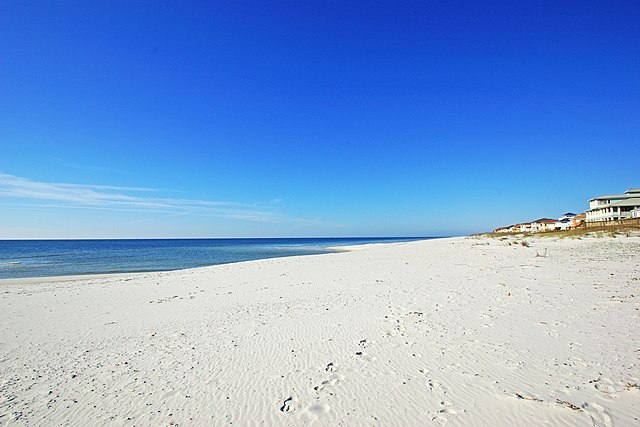Picture this: you’re sipping a cool drink, toes buried in warm sand, with the Gulf of Mexico’s waves crashing gently nearby. Sounds like paradise, right? That’s Gulf Shores, Alabama, calling your name! But before you pack your flip-flops and sunscreen, let’s talk about something that can make or break your beach getaway—the Gulf Shores weather. This coastal gem is known for its sunny vibes, but its climate has a few quirks you’ll want to know. Whether you’re planning a summer splash or a cozy winter escape, I’ve got you covered with this ultimate guide to Gulf Shores’ weather patterns, seasonal highlights, and pro tips for making the most of your trip. Let’s dive in!
Why Gulf Shores Weather Matters for Your Vacation
Ever shown up somewhere expecting sunshine and gotten a downpour instead? Yeah, it’s not fun. Gulf Shores’ weather plays a starring role in your vacation plans because it shapes everything from beach days to outdoor adventures. This slice of Alabama’s coast enjoys a humid subtropical climate, which means warm temperatures most of the year, but also some seasonal surprises. Understanding the weather helps you pack smart, pick the best activities, and avoid getting caught in a random afternoon shower. Plus, with Gulf Shores’ tourism booming—over 15,000 residents and millions of visitors annually—the weather impacts local events, dining, and even your rental options. So, let’s break it down and get you ready for whatever Mother Nature has in store!
What’s the Climate Like in Gulf Shores?
Gulf Shores sits on the northern Gulf of Mexico, where the climate feels like a warm hug most days. Think hot summers, mild winters, and a whole lot of humidity. The area averages about 223 sunny days a year—way above the national average—so you’re more likely to catch rays than rain. But don’t let those numbers fool you; the weather here can be as unpredictable as a plot twist in a summer blockbuster. From June’s steamy highs to January’s crisp lows, Gulf Shores keeps you on your toes. Annual rainfall hovers around 65 inches, with quick showers often popping up, especially in summer. Ready to unpack the seasons? Let’s go!
A Season-by-Season Breakdown of Gulf Shores Weather

Gulf Shores’ weather changes like the tides, with each season offering its own flavor. Whether you’re chasing sun-soaked beach days or cooler coastal strolls, here’s what to expect year-round. I’ll walk you through the temperatures, precipitation, and vibes of each season so you can plan your trip like a pro.
Summer: Sizzling Beach Days (June–August)
Summer in Gulf Shores is like stepping into a postcard—bright, hot, and full of life. Temperatures range from 70°F to 90°F, with humidity making it feel like you’re wrapped in a warm towel. July is the hottest month, often hitting 91°F, perfect for swimming or paddleboarding in the Gulf’s crystal waters. But here’s the catch: summer is also the wettest season, with about 7 inches of rain per month. Don’t worry, though—these are usually quick afternoon showers that clear up fast, leaving cooler evenings for sunset strolls. Pack lightweight clothes, sunscreen, and a rain jacket for those pop-up storms. Summer’s also peak tourist season, so book your beachfront rental early!
Pro Tip for Summer Visitors
Beat the heat by hitting the beach early in the morning or late in the afternoon. You’ll avoid the midday scorch and score some epic sunrise or sunset views. Also, check out indoor spots like the Gulf Coast Zoo if a storm rolls in.
Fall: Cooler Breezes and Fewer Crowds (September–November)
Fall is Gulf Shores’ best-kept secret. The weather cools slightly, with highs ranging from 50°F to 85°F. September still feels summery, but by November, you’ll need a light jacket for chilly mornings. Rainfall drops to about 5 inches per month, making it ideal for hiking or biking along the Hugh S. Branyon Backcountry Trail. The Gulf’s waters stay warm enough for swimming into October, and the crowds thin out, giving you more elbow room on the beach. Fall also brings festivals like the National Shrimp Festival, where you can feast on seafood under crisp autumn skies. It’s like summer’s fun without the sweat!
Why Fall is a Local Favorite
Locals love fall because it’s the sweet spot between summer’s hustle and winter’s quiet. You get sunny days, lower humidity, and cheaper rentals. Plus, the sunsets? They’re like a painting you can’t stop staring at.
Winter: Mild and Peaceful (December–February)
Winter in Gulf Shores laughs at snow. Instead, you get mild days with highs between 45°F and 70°F. January is the coolest month, averaging 60°F, but it’s still warm enough for golfing or strolling the boardwalk. Rainfall is low, around 4 inches per month, so you can skip the umbrella. The Gulf’s too chilly for swimming, but it’s perfect for indoor adventures like exploring the Alabama Gulf Coast Zoo or dining at beachfront restaurants. Winter’s also the quietest season, ideal for couples or retirees seeking a serene escape. Think cozy sweaters, hot coffee, and empty beaches.
Winter Activity Ideas
Embrace the chill with a dolphin-watching cruise or a visit to local museums. The Gulf Shores Museum has cool exhibits on the area’s history, and it’s a great way to dodge any rare rainy days.
Spring: Vibrant and Festive (March–May)
Spring in Gulf Shores is like a party waking up. Temperatures climb from 45°F to 85°F, with May feeling like summer’s warm-up act. Rainfall picks up slightly, averaging 5 inches, but it’s mostly brief showers. The beaches come alive with families, and the city hosts events like the Hangout Music Festival, where you can groove to live music with sand between your toes. Spring’s also great for fishing charters, as the Gulf teems with snapper and grouper. Pack layers to handle the temperature swings, and don’t miss the wildflowers blooming along coastal trails.
Spring Festival Highlights
The Hangout Music Fest in May is a must for music lovers. Imagine rocking out to top bands with the Gulf as your backdrop—does it get any better? Check the festival schedule early to snag tickets.
Key Weather Trends to Watch in Gulf Shores

Beyond the seasons, Gulf Shores’ weather has some patterns you’ll want to keep an eye on. These trends can help you fine-tune your plans and avoid any surprises. Let’s look at the big ones.
Hurricane Season: What You Need to Know
Gulf Shores sits in hurricane alley, with the official season running from June 1 to November 30. Peak activity hits in August and September, when warm Gulf waters fuel storms. Major hurricanes are rare, but tropical storms can bring heavy rain and wind. Check forecasts before your trip, especially in late summer, and have a flexible itinerary. Most rentals and hotels have hurricane policies, so review them when booking. If a storm’s brewing, locals are pros at keeping visitors informed, so follow updates from the National Weather Service or local news.
Humidity and Heat Index
Humidity in Gulf Shores is like an uninvited guest—it shows up and sticks around. Summer’s heat index can push the “feels-like” temperature past 100°F, even if the thermometer reads 90°F. Stay hydrated, take breaks in air-conditioned spots, and slather on sunscreen. Fall and spring offer lower humidity, making outdoor activities more comfortable. Winter’s humidity is barely noticeable, so you can roam freely without feeling like you’re in a sauna.
How to Plan Your Trip Around Gulf Shores Weather
Now that you know the weather, let’s talk strategy. Planning around Gulf Shores’ climate is like packing for a road trip—you need the right gear and a good map. Here’s how to make the weather work for you.
Best Times to Visit for Your Vibe
Love packed beaches and lively vibes? Summer’s your jam, but book early to beat the crowds. Prefer quiet walks and budget-friendly stays? Winter’s serene and wallet-friendly. Want a mix of warm weather and fewer tourists? Spring or fall hits the sweet spot. Check event calendars, too—festivals can spike crowds but add tons of fun. For example, the National Shrimp Festival in October draws thousands, so plan ahead if you’re shrimp-obsessed!
Packing Tips for Every Season
Packing for Gulf Shores is all about versatility. Summer calls for swimsuits, shorts, and breathable fabrics, plus a rain jacket. Fall and spring need layers—think T-shirts, hoodies, and light jackets. Winter’s mild, but pack long pants and a cozy sweater for evenings. Year-round, bring comfy shoes for beach walks and bug spray for trails. And don’t forget sunglasses—those sunny days are no joke!
Weather’s Impact on Gulf Shores Activities
The weather doesn’t just affect your wardrobe; it shapes what you do in Gulf Shores. From beach days to fishing trips, here’s how to match your plans to the forecast.
Beach and Water Activities
Summer and early fall are prime for swimming, kayaking, and jet-skiing, with Gulf waters hitting 80°F or higher. Spring’s warm enough for water sports, but check for red tide alerts, which can affect water quality. Winter’s too cool for swimming, but beachcombing and kite-flying are awesome. Always check surf conditions—rip currents can pop up, especially after storms.
Outdoor Adventures Beyond the Beach
Gulf Shores’ trails and parks shine in fall and spring, when mild weather makes hiking or biking a breeze. The Bon Secour National Wildlife Refuge is a must for birdwatchers, with migratory species passing through. Summer’s great for fishing charters, but book morning trips to dodge afternoon heat. Winter’s ideal for golfing at courses like Peninsula Golf Club, where sunny days and cool breezes create perfect conditions.
Where to Check Gulf Shores Weather Forecasts
Want to stay ahead of the weather? Reliable forecasts are your best friend. Sites like Weather Underground and AccuWeather offer detailed Gulf Shores updates, including 10-day forecasts and hourly breakdowns. The Weather Channel’s app is handy for real-time alerts, especially during hurricane season. For marine conditions, Buoyweather.com gives wind and tide data—perfect for boaters or anglers. Follow @NWSMobile on X for severe weather updates, like the special statement issued on June 10, 2025, for Gulf Shores. Pro tip: check forecasts a week before your trip, then daily as you get closer.
Conclusion: Embrace the Gulf Shores Weather
Gulf Shores’ weather is like a good friend—mostly sunny, occasionally moody, but always ready for fun. Whether you’re chasing summer’s heat, fall’s festivals, winter’s calm, or spring’s energy, this coastal paradise delivers. By understanding the seasons, packing smart, and planning around the forecast, you’ll make every moment count. So, what are you waiting for? Grab your sunglasses, check the weather, and let Gulf Shores’ sandy shores and salty air sweep you away. Your perfect beach adventure is just a forecast away!
FAQs About Gulf Shores Weather
- What’s the best month to visit Gulf Shores for warm weather and fewer crowds?
October is a sweet spot—warm days, cooler nights, and fewer tourists than summer. You’ll enjoy beach time and events like the National Shrimp Festival without the peak-season hustle. - Does Gulf Shores get hurricanes often?
Major hurricanes are rare, but tropical storms can hit during the June–November season. August and September are the riskiest months, so monitor forecasts and have a backup plan. - Can you swim in the Gulf during winter?
The water’s too cold for most, dipping to around 60°F. Stick to beach walks or indoor activities like visiting the Gulf Shores Museum instead. - How rainy is Gulf Shores in summer?
Summer sees about 7 inches of rain per month, mostly in quick afternoon showers. Pack a rain jacket, but expect plenty of sunny hours for beach fun. - Where can I find reliable Gulf Shores weather updates?
Check Weather Underground, AccuWeather, or The Weather Channel for detailed forecasts. For real-time alerts, follow @NWSMobile on X or use the Buoyweather app for marine conditions.

